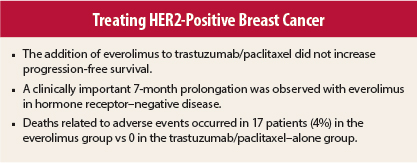In the phase III BOLERO-1 trial, reported in The Lancet Oncology, Sara A. Hurvitz, MD, of the University of California, Los Angeles, and colleagues found that the addition of the mTOR inhibitor everolimus (Afinitor) to trastuzumab (Herceptin)/paclitaxel did not significantly increase progression-free survival among patients with HER2-positive metastatic breast cancer.1 A 7-month prolongation in progression-free survival was observed with everolimus among hormone receptor–negative patients.
Study Details
In this double-blind trial, 719 patients from 28 countries were randomly assigned 2:1 between September 2009 and December 2012 to receive first-line everolimus (n = 480) or placebo (n = 239) plus trastuzumab and paclitaxel. Everolimus was given orally at 10 mg once daily, trastuzumab was given intravenously at a 4 mg/kg loading dose on day 1 with subsequent weekly doses of 2 mg/kg in each 4-week cycle, and paclitaxel was given intravenously at 80 mg/m² on days 1, 8, and 15 of each cycle.
To be eligible for the trial, patients could not have received previous systemic therapy for advanced disease, except endocrine therapy that was discontinued due to disease progression before randomization. Neoadjuvant or adjuvant trastuzumab or chemotherapy had to have been stopped ≥ 12 months before randomization. Randomization was stratified by previous trastuzumab administration and visceral metastasis.
The two primary objectives were investigator-assessed progression-free survival in the full study population and in the subset of patients with hormone receptor–negative disease, with the latter objective being added during the course of the study based on new clinical and biologic findings. Efficacy analyses were in the intent-to-treat population.
Patient Characteristics
In the everolimus and placebo groups, 208 patients (43%) and 103 patients (43%) had hormone receptor–negative disease. The everolimus and placebo groups were generally balanced for age (median, 54 and 52 years [56 and 53 years in hormone receptor–negative population]), ethnicity (45% and 41% Caucasian, 41% and 44% Asian [46% and 38% Caucasian, 41% and 46% Asian]), Eastern Cooperative Oncology Group performance status (0 for 58% and 62% [0 for 61% and 63%]), metastatic disease (93% in both [92% in both]), visceral involvement (70% and 71% [65% and 70%]), and bone involvement (44% and 49% [33% and 45%]),
The two groups were also balanced in terms of previous therapy (neo/adjuvant trastuzumab in 11% in both, neo/adjuvant chemotherapy in 45% and 51%, taxane in 24% and 27%, anthracycline in 39% and 47%, other chemotherapy in 40% and 46% [neo/adjuvant trastuzumab in 11% and 13%, neo/adjuvant chemotherapy in 39% and 52%, taxane in 25% in both, anthracycline in 34% and 50%, other chemotherapy in 36% and 50%]), hormonal therapy for hormone receptor–positive disease (neo/adjuvant in 19% and 20%, metastatic in < 1% in both, neoadjuvant or adjuvant and metastatic in 5% and 3%), and radiotherapy (36% and 41% [26% and 39%]). All patients had undergone surgery.
Key Outcomes
Median follow-up was 41.3 months. In the full population, median progression-free survival was 14.95 months (95% confidence interval [CI] = 14.55–17.91 months) in the everolimus group vs 14.49 months (95% CI = 12.29–17.08 months) in the placebo group (hazard ratio [HR] = 0.89, P = .1166). In the hormone receptor–negative subpopulation, median progression-free survival was 20.27 months (95% CI = 14.95–24.08 months) in the everolimus group vs 13.08 months (95% CI = 10.05–16.56 months) in the placebo group (HR = 0.66, P = .0049); however, the protocol-specified significance threshold of P = .0044 was not crossed.
Objective response rates were 67.1% vs 69.0% in the full population and 73.1% vs 70.9% in the hormone receptor–negative population.
Dose Intensity
Median relative dose intensity was 0.54 for everolimus (compared with 0.96 for placebo) among all patents and 0.53 (compared with 0.95) in the hormone receptor–negative population. Dose interruption or reduction was performed in 86% of everolimus recipients vs 74% of placebo recipients in the full population and 85% vs 74% in the hormone receptor–negative population.
Adverse Events
The most common adverse events of any grade in the everolimus group were stomatitis (67% vs 32% in the placebo group), diarrhea (57% vs 47%), and alopecia (47% vs 53%). The most common grade 3 or 4 adverse events in the everolimus group were neutropenia (25% vs 15%), stomatitis (13% vs 1%), anemia (10% vs 3%), and diarrhea (9% vs 4%).
Serious adverse events occurred in 36% vs 15% of patients, with the most common in the everolimus group being pneumonitis (4%), pneumonia (4%), and pyrexia (3%). Adverse events led to treatment discontinuation in 55% of the everolimus group vs 40% of the placebo group, with the most common causes being peripheral neuropathy (8% vs 8%), neurotoxicity (6% vs 8%), and pneumonitis (6% vs < 1%).
On-treatment deaths related to adverse events occurred in 17 patients (4%) in the everolimus group and in no patients in the placebo group. Causes of death in the everolimus group included respiratory and thoracic disorders in eight patients; infections (including respiratory) in five; and cardiac disorder, cerebrovascular accident, injury, and metabolic acidosis in one patient each.
The investigators concluded: “Although progression-free survival was not significantly different between groups in the full analysis population, the 7.2 months prolongation we noted with the addition of everolimus in the [hormone receptor]-negative, HER2-positive population warrants further investigation, even if it did not meet prespecified criteria for significance. The safety profile was generally consistent with what was previously reported in BOLERO-3. Proactive monitoring and early management of adverse events in patients given everolimus and chemotherapy is crucial.” ■
Disclosure: The BOLERO-1 study was funded by Novartis Pharmaceuticals. For full disclosures of the study authors, visit www.thelancet.com.
Reference
1. Hurvitz SA, Andre F, Jiang Z, et al: Combination of everolimus with trastuzumab plus paclitaxel as first-line treatment for patients with HER2-positive advanced breast cancer (BOLERO-1): A phase 3, randomised, double-blind, multicentre trial. Lancet Oncol. June 16, 2015.



